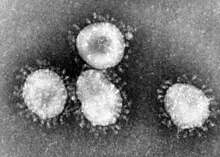Corona virus
| Coronavirus | |
|---|---|
 |
|
| Virus classification | |
| Group: | Group IV ((+)ssRNA) |
| Order: | Nidovirales |
| Family: | Coronaviridae |
| Subfamily: | Coronavirinae |
| Genus: | |
| Type species | |
|
Coronavirus |
|
| Species | |
|
Human coronavirus HKU1 |
|
Human coronavirus HKU1
Human coronavirus OC43
Human coronavirus 229E
MERS-CoV
SARS-CoV
Pipistrellus bat coronavirus HKU5
Tylonycteris bat coronavirus HKU4
Rousettus bat coronavirus HKU9
Bat SL-CoV-WIV1
London1 novel CoV/2012
HCoV-EMC/2012
Coronaviruses are species in the genera of virus belonging to one of two subfamilies Coronavirinae and Torovirinae in the family Coronaviridae, in the order Nidovirales. Coronaviruses are enveloped viruses with a positive-sense single-stranded RNA genome and with a nucleocapsid of helical symmetry. The genomic size of coronaviruses ranges from approximately 26 to 32 kilobases, the largest for an RNA virus.
The name "coronavirus" is derived from the Latin corona, meaning crown or halo, and refers to the characteristic appearance of virions under electron microscopy (E.M.) with a fringe of large, bulbous surface projections creating an image reminiscent of a royal crown or of the solar corona. This morphology is created by the viral spike (S) peplomers, which are proteins that populate the surface of the virus and determine host tropism.
...
Wikipedia
